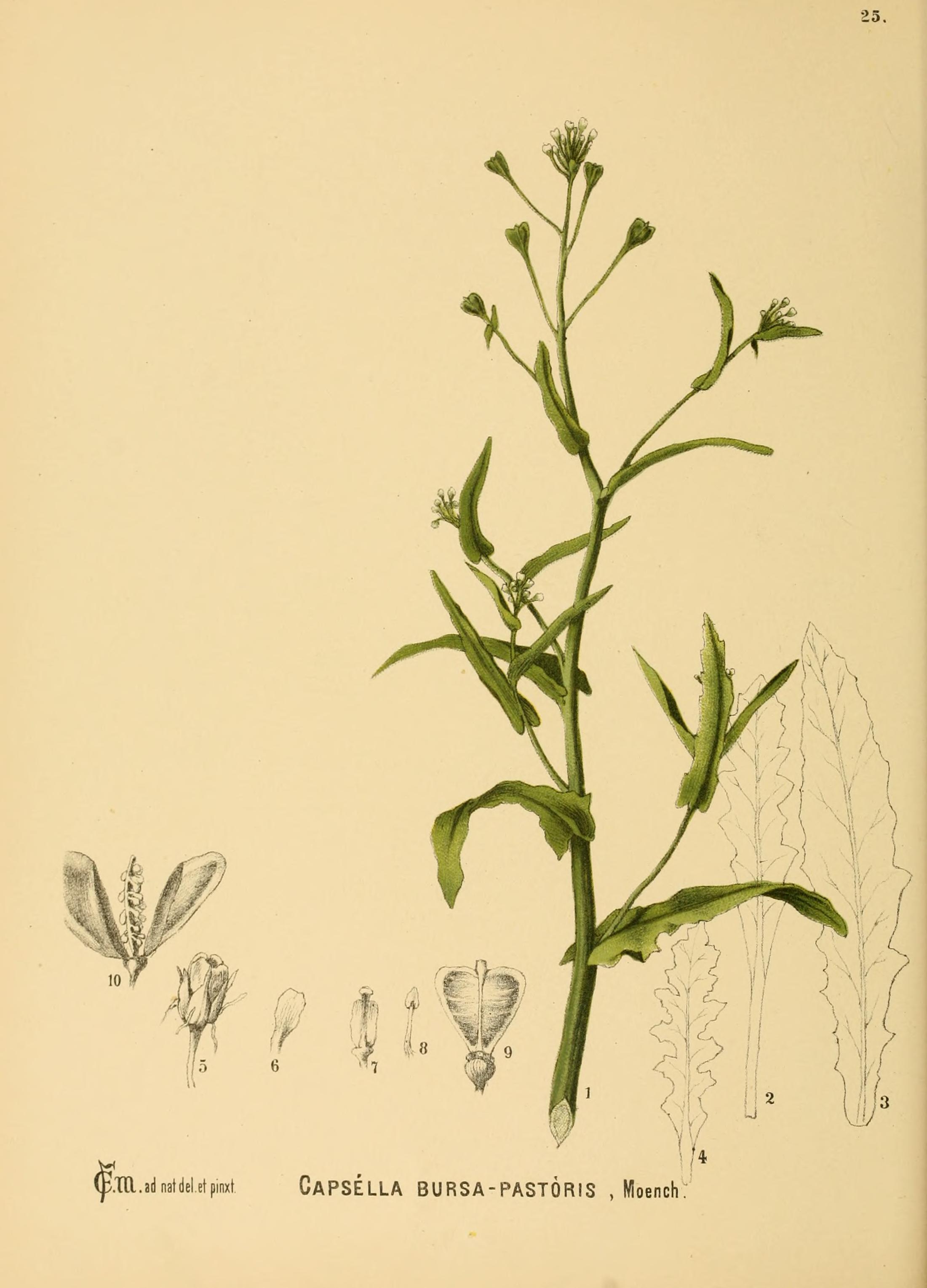Capsella bursa-pastoris (L)
Synonyms and Common names: Witch�s pouches, pickpocket, shepherd�s
bag, shepherd�s scrip, shepherd�s sprout, shepherd�s heart, lady�s
purse, rattle pouches, case- weed, blindweed, poor man�s parmacettie, pepper
and salt, mother�s heart, cocowort, toywort, St. James� weed
weed, blindweed, poor man�s parmacettie, pepper
and salt, mother�s heart, cocowort, toywort, St. James� weed
French = bourse de pasteur, German = hirtentasche or hirtenfaschel, Spanish = Borsa de Pastor, Italian = Borsa di pastore, Irish = clappedepouch
Order: Cruciferae
Description: Capsella is an annual or biennial herb growing up to 60cm in height, indigenous to Europe and West Africa. A common weed in gardens and fields, it also grows on waste ground and in hedgerows. A rosette of basal leaves grows first, and these are long, tapering, pinnately compound, lobed to entire and narrowing towards the stalk. The stem leaves have no petioles and are enclosing and glabrous. The main stem is erect, the others ascending and terminating in racemes of tiny bisexual white cruciferous flowers, 2-3mm in diameter. The calyx consists of four oval, bowl-shaped, open green sepals; the corolla comprises four oblong white petals, twice as long as the calyx; sometimes it is stunted or undeveloped. There are six stamens with yellow anthers. The flat, heart-shaped pod contains numerous small, oval brown seeds. Capsella flowers from March to November.
Parts used: aerial parts
Collection: during the flowering period
Constituents: flavonoids (luteolin 7-rutinoside and quercitin 3-rutinoside), polypeptides, fumaric and bursic acids, amines (choline, acetylcholine, histamine and tyramine), saponins, tannin, mustard oil, volatile oil (including camphor).
Actions: uterine stimulant, diuretic, astringent, anti-haemorrhagic, urinary antiseptic, antipyretic
Indications: uterine haemorrhage, varicose veins
Therapeutics and Pharmacology: Capsella�s haemostatic action is due to the presence of tyramine and other amines, and the acetylcholine, choline and tyramine have been shown to produce a transient decrease in blood pressure and haemostatic activity in vivo. It can be used to treat urinary infections with haematuria, and menorrhagia. The polypeptides have a contractile action on the uterus. It is also of benefit in the treatment of haemorrhoids and varicose veins. The flavonoids have an anti-inflammatory action and the tannins are astringent. Capsella is an effective treatment for diarrhoea. It is also diuretic, due in part to the presence of mustard oil. Weak antibacterial activity mainly towards Gram-positive organisms has been reported.
Combinations: Capsella combines well with Trillium and Hydrastis in menorrhagia or metrorrhagia, and with Barosma in cystitis.
Preparation and Dosage: (thrice daily)
Regulatory Status: GSL Schedule 1
Dried herb: 1-4g or by infusion
Liquid Extract: 1:1 in 25% alcohol, 1-4ml
Additional Comments: The heart-shaped fruits of this plant resemble the purses that people used to hang from their belts in the Middle Ages. During the First World War, when the standard haemostatic herbs Hydrastis and Claviceps were unobtainable in Britain, Capsella was used as an alternative. It has also been used as a quinine substitute in the treatment of malaria. In Chinese medicine it is used to treat dysentery and eye problems.
Bibliography
Bartram, T. 1995 Encyclopaedia of Herbal Medicine, 1st edn., Grace Publishers, Bournemouth.
Bremness, L. 1994 Herbs, Dorling Kindersley Eyewitness Handbook, London.
BHMA 1983 British Herbal Pharmacopoeia, BHMA, Bournemouth.
Chevallier, A. 1996 The Encyclopaedia of Medicinal Plants, Dorling Kindersley, London.
Grieve, M. 1931 A Modern Herbal, (ed. C.F. Leyel 1985), London.
Grigson, G. 1996 (2nd.edn.) The Englishman�s Flora, Helicon Publishing, Oxford.
Hoffmann, D. 1990 The New Holistic Herbal, Second Edition, Element, Shaftesbury.
Lust, J. 1990 The Herb Book, Bantam, London.
Mabey, R. (ed.) 1991 The Complete New Herbal, Penguin, London.
Newall, C.A., Anderson, L.A., & Phillipson, J.D. 1996 Herbal Medicines: A Guide for Health-care Professionals, The Pharmaceutical Press, London.
Ody, P. 1993 The Herb Society's Complete Medicinal Herbal, Dorling Kindersley, London.
Polunin, M. and Robbins, C. 1992 The Natural Pharmacy, Dorling Kindersley, London.
Prihoda, A. 1989 The Healing Powers of Nature, Octopus, London.
Weiss, R.F. 1991 Herbal Medicine, Beaconsfield Arcanum, Beaconsfield.
Wren, R.C. 1988 Potter's New Cyclopaedia of Botanical Drugs and Preparations, C.W.Daniel, Saffron Walden.










